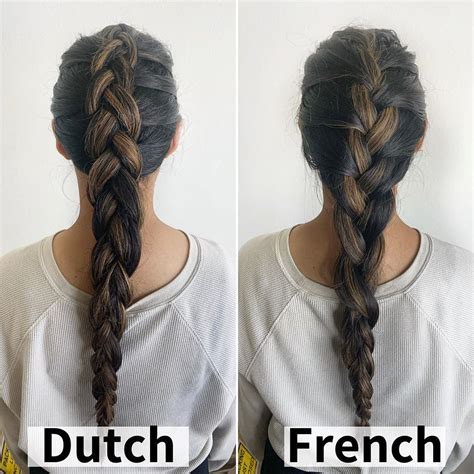1. Origin and History
Dutch Braids
Originating in the Netherlands, Dutch braids, also known as inverted French braids, date back to the 16th century. The unique weaving technique was developed by rural women seeking a practical and decorative hairstyle for their daily work.

French Braids
French braids, on the other hand, emerged in France around the 18th century as an elegant and sophisticated hairstyle for the upper classes. Their elaborate construction symbolized the intricate social hierarchy of the era.
2. Construction Method
Dutch Braids
Dutch braids are created by picking up sections of hair from underneath and weaving them over the center strand, resulting in a raised, three-dimensional effect. This technique creates volume and texture, enhancing the appearance of thicker, fuller hair.
French Braids
French braids start with a traditional three-strand braid at the crown of the head, gradually adding hair from the sides as you braid down. The hair is picked up from above and woven under the center strand, creating a flat and intricate pattern.
3. Appearance and Texture
Dutch Braids
Dutch braids are characterized by their puffy, textured finish due to the hair being pulled up from underneath. They are ideal for creating a more voluminous look, especially in thinner or flat hair.
French Braids
French braids result in a sleek and polished appearance, with the strands lying flat against the scalp. They add an air of sophistication and elegance, making them a popular choice for formal events.
4. Holding Power and Versatility
Dutch Braids
Dutch braids are known for their strong hold, making them perfect for active lifestyles or extended wear. The raised structure helps to keep the hair in place, preventing it from becoming loose or frizzy.
French Braids
While less secure than Dutch braids, French braids offer greater versatility. They can be styled in a variety of ways, from buns and chignons to ponytails and braids, making them suitable for various occasions.
5. Suitability and Occasion
Dutch Braids
Dutch braids are a versatile hairstyle that complements a wide range of face shapes and hair textures. They are especially flattering on round or square faces, as they add volume and balance to the features.
French Braids
French braids are best suited for individuals with oval or heart-shaped faces. Their intricate design draws attention to the neckline and shoulders, making them an excellent choice for formal affairs or special occasions.
Tables for Comparison
Table 1: Construction Techniques
| Feature | Dutch Braids | French Braids |
|---|---|---|
| Hair sections | Picked up from underneath | Picked up from above |
| Weave direction | Over the center strand | Under the center strand |
| Appearance | Puffy and textured | Sleek and flat |
Table 2: Holding Power and Versatility
| Feature | Dutch Braids | French Braids |
|---|---|---|
| Holding power | Strong | Moderate |
| Versatility | Less versatile | More versatile |
Table 3: Suitability and Occasion
| Feature | Dutch Braids | French Braids |
|---|---|---|
| Face shapes | Round, square | Oval, heart-shaped |
| Occasions | Everyday, active | Formal, special events |
Table 4: Benefits and Drawbacks
| Feature | Dutch Braids | French Braids |
|---|---|---|
| Benefits: | ||
| Adds volume | Strong hold | Sleek appearance |
| Drawbacks: | ||
| Less versatile | Can be challenging to master | Less secure |
Conclusion
Both Dutch and French braids offer distinct advantages and cater to different preferences. Dutch braids provide volume and texture, ideal for everyday wear and active lifestyles. French braids exude elegance and sophistication, making them perfect for formal occasions. Ultimately, the best choice depends on an individual’s hair type, face shape, and desired look.
